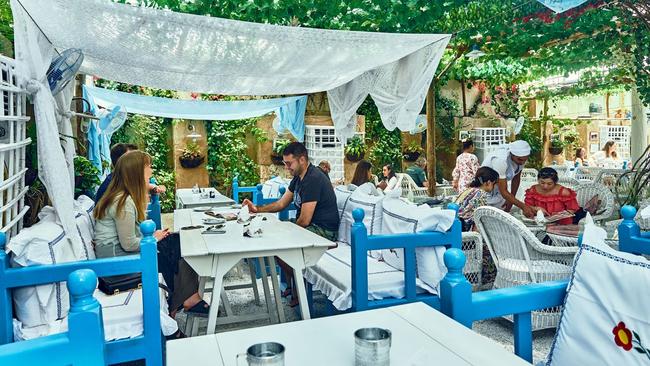Dubai’s Al Fahidi Historical District offers glimpses of the past
Leave the bling behind in Dubai’s old quarter.

Football commentators are fond of the expression “lowering the eyes”. It describes an astute decision by a player to forgo trying to kick a goal in favour of more modest short-term gains. A low pass to a teammate in a good position can be better than a speculative hoof at goal.
Lowering your eyes from the bright lights and high-rise glamour of Dubai, nicknamed the City of Superlatives, can be difficult. It’s impossible to stand under the 830m-tall Burj Khalifa and not be rendered momentarily speechless by its sheer audacity. Construction is under way on the even taller Dubai Creek Tower which, according to reports, will reach more than a kilometre into the sky. (Developers won’t say what the final height is going to be to prevent potential rivals from going a metre higher, and then what good would it be?)
I decide to seek out not the world’s largest mall or the world’s largest man-made island or the world’s only seven-star hotel but a small piece of land beside Dubai Creek that’s about as close as you’ll get in Dubai to a preserved historic village.

Al Fahidi Historical District is a discreet block of shell and coral stone homes in Bur Dubai, channelled by a labyrinth of flagstone laneways. The first settled area of Dubai, it’s hardly old on a world scale, springing up on Dubai Creek in the early 1900s, when it became an outpost for the Persian Gulf pearling industry. Strict taxes in Iran drove pearling merchants to leave and set up shop here in Dubai, which was free from duty.
They brought with them Iranian architecture, particularly the style of wind towers, designed to funnel cooling sea breezes down into homes, a kind of desert airconditioning and still an attractive feature of the place. The area became known as Bastakiya, after Bastak, the town in southern Iran from where many of the merchants originated. The Depression and the introduction of the cultured pearl killed off pearling and sent Dubai into an economic slump.
And while the discovery of oil brought wealth to the emirate states, by the 1980s the oil price had plummeted and Bastakiya became derelict. In 1989 an order was placed to raze what remained.
Rayner Otter, a British architect who lived in the area, launched a campaign to spare the district from the wrecking ball, going so far as to enlist the help of Prince Charles, who implored authorities to halt the demolition. Thus, the last remaining glimpse of the heart of old Dubai was, at least partially, preserved.

The Al Fahidi of today is about as understated and artisan as Dubai gets, with quiet cafes set inside conspiratorial courtyards, small galleries sunk into bunker-like caverns, tasteful craft shops and even a resident cat that parades, tail in air, near the remains of the old city wall.
Entering the Arabian Tea House is like passing through a portal. I’m whisked through the low doorway into a casual dining area furnished with turquoise benches, white rattan chairs and a pebble floor. With so much of Dubai given over to international cuisine it’s refreshing to see an all-Arabian and Emirati menu. I order the Levantine-inspired khameer haloumi zaatar (a sweet bread coated with egg and filled with haloumi cheese, cucumber, tomato and zaatar) and it’s sensational. I suddenly feel insulated from the excesses of Dubai, taking disproportionate pleasure in sitting on a rattan chair eating a simple, tasty sandwich.
After lunch I meet my Arabian Adventures guide, Syrian national Nabil. “I’m a citizen of the world,” he says, making a circle with his hands. “We all are.”
Dubai is a city of expats. UAE citizens make up only about 10 per cent of the population, and Nabil — who is charismatic, whimsical and relentlessly positive — makes our tour of the sights of Al Fahidi as much about the people who live in this global melting pot (an apt description, especially in the hotter months).
We follow a bird chorus into the courtyard of XVA Art Hotel, probably the most “un-Dubai” hotel that exists. When owner Mona Saudi opened XVA in 2003 there was no concept of a boutique hotel in Dubai.

I meet Saudi in the elegant internal courtyard. Like many buildings in Al Fahidi, XVA is fortress-like in its architecture, with high walls giving way to a hollowed out, bunker-like centre and trees growing assertively through the pavers.
Saudi ushers me into her office, a mere nook in the rock, and plonks a book on my lap. It’s a photo essay of Dubai in 1962, the definitive pictorial document of pre-oil Dubai, by Japanese journalist Yoshio Kawashima.
The city as we know it today doesn’t exist on these pages. They depict a desert settlement, a sandy swath of laneways and shacks, Arab traders in crowded markets, fishing boats and barefoot children. Not one of those people in the photos could have predicted the behemoth Dubai would become. I’m sitting in one of the last remaining vestiges of that world. Saudi smiles. “It’s pretty incredible, huh?”
It’s in the art galleries where Al Fahidi really comes alive, and XVA has one of the best, showcasing ever-changing exhibitions of contemporary works from the Middle East and the Indian subcontinent. There’s nothing flashy or overly attention-grabbing about the place, just a relaxed, understated elegance — a recurring feature everywhere I go in Al Fahidi. Inside the Alserkal Cultural Foundation I’m stunned by a beautiful display of shadow art by Jordanians Bassam Al Selawi and Maysoon Masalha. Brass sculptures are lit from above or below, casting a shadow on to the wall: two lovers entwined, a chain of camels marching across the desert, a falcon taking to the sky. The artwork is fragile, soft and enchanting.
From Al Fahidi we take an abra, a wooden water taxi, across Dubai Creek to the district of Deira. Scores of dhows (traditional, thin-hulled sailing boats) once sliced through this creek at the height of the pearling trade. These days the waters churn with abras delivering shoppers to the famous spice and gold souks that give the area its colour and intoxicating aromas. After the calmness of Al Fadihi, it’s a shock to be spat out into a busy market where spruikers claw at my wrist to peruse their wares. I can’t resist buying a small fortune in saffron and haggling down what may or may not be a substantial bargain on a cashmere pashmina. I’m about to leave the souk when something truly extravagant catches my eye in the window of a jewellery shop: an enormous, extravagant gold ring, the size of a coffee table.
Nabil smiles. “That, my friend, is the largest gold ring in the world.”
How could it not be? Al Fahidi is just over the creek but might as well be a world away. Welcome back to Dubai.
Ricky French was a guest of Emirates.
-
IN THE KNOW
Arabian Adventures offers a guided, half-day tour of Al Fahidi Historical District, including a visit to Dubai Museum (located inside Al Fahidi Fort, the oldest surviving building in the city, dating from 1787), an abra ride across Dubai Creek and a tour of the spice and gold souks; AED185 ($75), hotel pick-up and drop-off included. Emirates flies direct to Dubai from Adelaide and Perth daily, and from Brisbane, Sydney and Melbourne three times daily.

To join the conversation, please log in. Don't have an account? Register
Join the conversation, you are commenting as Logout